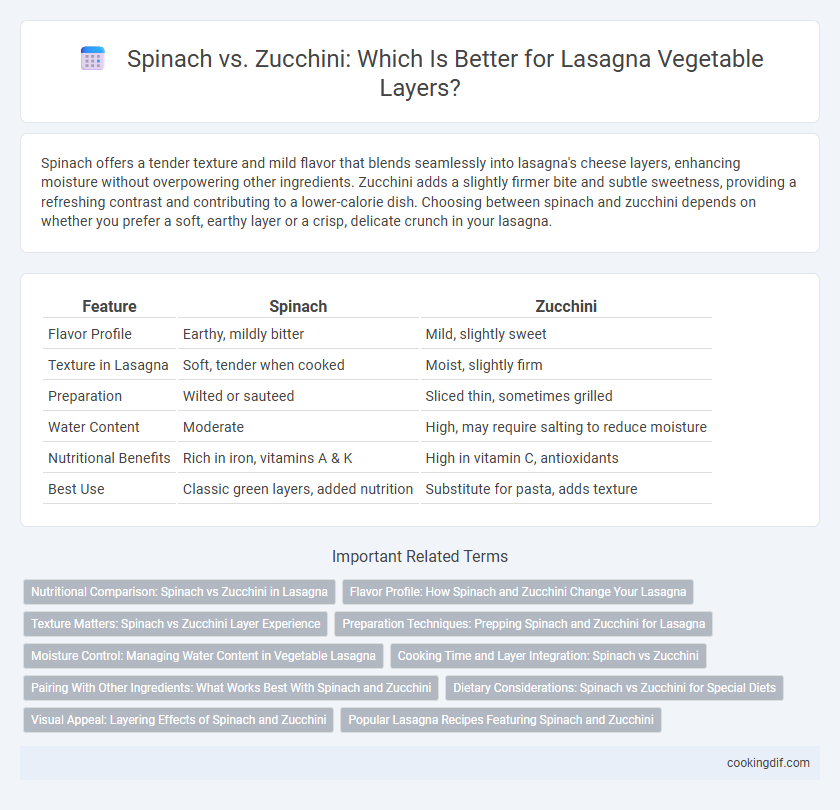Spinach offers a tender texture and mild flavor that blends seamlessly into lasagna's cheese layers, enhancing moisture without overpowering other ingredients. Zucchini adds a slightly firmer bite and subtle sweetness, providing a refreshing contrast and contributing to a lower-calorie dish. Choosing between spinach and zucchini depends on whether you prefer a soft, earthy layer or a crisp, delicate crunch in your lasagna.
Table of Comparison
| Feature | Spinach | Zucchini |
|---|---|---|
| Flavor Profile | Earthy, mildly bitter | Mild, slightly sweet |
| Texture in Lasagna | Soft, tender when cooked | Moist, slightly firm |
| Preparation | Wilted or sauteed | Sliced thin, sometimes grilled |
| Water Content | Moderate | High, may require salting to reduce moisture |
| Nutritional Benefits | Rich in iron, vitamins A & K | High in vitamin C, antioxidants |
| Best Use | Classic green layers, added nutrition | Substitute for pasta, adds texture |
Nutritional Comparison: Spinach vs Zucchini in Lasagna
Spinach provides a high concentration of iron, calcium, and vitamins A and K, making it a nutrient-dense choice for lasagna layers, while zucchini offers a lower calorie count with significant amounts of vitamin C and potassium. Spinach's dense fiber content supports digestion and helps maintain blood sugar levels, whereas zucchini contributes to hydration due to its high water content. Both vegetables enhance lasagna with distinct nutritional benefits, but spinach generally delivers more essential micronutrients per serving.
Flavor Profile: How Spinach and Zucchini Change Your Lasagna
Spinach imparts a rich, earthy flavor with slightly bitter undertones that enhance the savory depth of lasagna, while zucchini offers a mild, slightly sweet taste that provides a subtle freshness and moisture to each layer. The tender texture of cooked spinach blends seamlessly into the cheese and sauce, intensifying the overall creaminess, whereas zucchini's higher water content creates a lighter, juicier bite that balances hearty meat or tomato layers. Choosing spinach elevates the complexity and robust character of the dish, while zucchini delivers a delicate, crisp contrast, making each vegetable distinctively alter the flavor profile of your lasagna.
Texture Matters: Spinach vs Zucchini Layer Experience
Spinach layers in lasagna offer a tender, wilted texture that melds seamlessly with creamy ricotta, enhancing the dish's moist consistency. Zucchini provides a firmer, slightly crunchy bite that adds structural contrast and prevents the layers from becoming too soft or soggy. Choosing between spinach and zucchini significantly impacts the lasagna's overall mouthfeel and balance of textures.
Preparation Techniques: Prepping Spinach and Zucchini for Lasagna
Preparing spinach for lasagna involves thoroughly washing and draining to remove excess moisture, often followed by sauteing to reduce water content and enhance flavor. Zucchini requires slicing into thin strips or rounds and can be either roasted, grilled, or lightly sauteed to prevent sogginess and maintain texture within the vegetable layers. Both vegetables benefit from proper moisture control techniques to ensure the lasagna layers hold structure and deliver a balanced taste.
Moisture Control: Managing Water Content in Vegetable Lasagna
Spinach's high water content requires thorough squeezing to prevent soggy lasagna layers, while zucchini, also watery, benefits from salting and draining to remove excess moisture. Using both vegetables in balanced amounts can enhance texture without compromising structural integrity. Proper moisture control ensures a firm, cohesive lasagna that maintains its layered form during baking and serving.
Cooking Time and Layer Integration: Spinach vs Zucchini
Spinach cooks quickly, wilting down to a soft, moist layer that seamlessly integrates into lasagna, preserving a tender texture without requiring pre-cooking. Zucchini has a firmer consistency and longer cooking time, often needing to be thinly sliced and pre-roasted or sauteed to prevent excess moisture and ensure it melds smoothly within the layers. Choosing spinach or zucchini influences both the lasagna's structural integrity and overall moisture balance, with spinach offering a quicker, more uniform integration and zucchini contributing a heartier, slightly firmer bite.
Pairing With Other Ingredients: What Works Best With Spinach and Zucchini
Spinach pairs exceptionally well with ricotta cheese, garlic, and nutmeg, creating a creamy and savory layer that enhances traditional lasagna flavors. Zucchini complements tomato-based sauces, mozzarella, and basil, offering a mild, slightly sweet texture that balances acidity. Both vegetables contribute distinct tastes and textures, making them versatile choices depending on desired flavor profiles and ingredient combinations.
Dietary Considerations: Spinach vs Zucchini for Special Diets
Spinach offers a rich source of iron and calcium, making it ideal for vegetarian and nutrient-focused diets, while zucchini is lower in calories and carbohydrates, suitable for low-carb and keto plans. Both vegetables provide dietary fiber, but spinach includes higher levels of antioxidants and vitamins A and K, beneficial for anti-inflammatory diets. For individuals with oxalate sensitivities, zucchini presents a safer option due to spinach's higher oxalate content.
Visual Appeal: Layering Effects of Spinach and Zucchini
Spinach offers a rich, dark green hue that creates dense, vibrant layers in lasagna, enhancing visual depth and contrast against creamy cheeses and tomato sauce. Zucchini slices provide a lighter, translucent green tone with subtle ridged textures, adding delicate visual layers and freshness to the dish. The choice between spinach and zucchini significantly influences the lasagna's aesthetic by varying color intensity and textural layering effects.
Popular Lasagna Recipes Featuring Spinach and Zucchini
Popular lasagna recipes featuring spinach highlight its tender texture and rich nutritional profile, providing a vibrant green layer packed with iron and vitamins A and C. Zucchini lasagna layers offer a slightly firmer bite and mild flavor, adding moisture and low-calorie bulk while complementing tomato and cheese components. Both vegetables enhance lasagna's health benefits, with spinach favored in traditional Italian versions and zucchini prominent in gluten-free or low-carb adaptations.
Spinach vs Zucchini for vegetable layers Infographic

 cookingdif.com
cookingdif.com